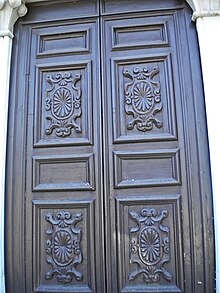Bolection

A bolection, sometimes called balection, bilection or similar, is a moulding which projects beyond the face of a panel or frame, usually found in panelling, doors and fireplaces, especially when the meeting surfaces are at different levels. Bolection was used to great effect by Christopher Wren [where?].[1]
The term was first used in the early 18th century; its etymology is uncertain.[2]
Bolection mouldings are also used to hold a panel in a door when the panel is not set into a continuous dado (groove) that surrounds the panel. The mouldings are usually rabbeted and are attached to the door stiles and rails but are not attached to the panel which is allowed to float freely (expand and contract).[citation needed]

References
- ^ Briggs, Martin S. (1962). Everyman's Concise Encyclopedia of Architecture. London: JM Dent & Sons. p. 51.
{{cite book}}:|access-date=requires|url=(help); Cite has empty unknown parameter:|coauthors=(help) - ^ The OED states that the first use was in 1708 by E. Hatton in his New View London: "A Gallery..the front of which is large Bolection, with raised Pannels."
